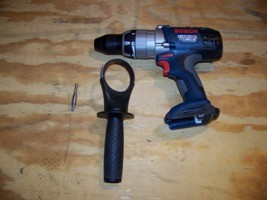When looking at any new power tools, whether it be a power drill or anything else, the first question you should ask yourself is “how does it feel in my hand?”Any tool should feel like an extension of your hand. The tool may feel great while standing in the store aisle but how about after a few hours of use. While in the store, make sure all controls are convenient, and check to see if the forward/reverse and high/low speed switches in particular are easy to use.
Drills come in three distinct handle styles. The most popular cordless models have the T-handle style where the handle is placed near the middle. The T-handle style distributes the weight for better balance and less wrist strain. Some tool users prefer the more traditional pistol-grip style, and last, the third style is the right-angle version, designed for use where space is restricted.
The next question to ask yourself is “how much power do I need?” Cordless drills are measured in volts. Drills are available in everything from around 2 volts (for a cordless screwdriver) to 24-volt tools, well the actually range higher for professional models. Higher voltage means heavier weight, so consider buying a tool that will meet 80-90% of your needs. 18 volt models are the most popular, and they will usually meet most homeowner’s work needs. Corded drills are measured in amps. Generally, a higher amperage motor means more power. Cordless batteries also have amp measurements, but will get to that at another time.
You must also consider what type of jobs you most likely will be using the drill for, or to put it another way, what type of material will you be working on with your new drill? Drilling softwood, hardwood, metal, and masonry all require different drill speeds. Harder materials or larger bits have to be worked at lower speed. Conversely, softer materials and smaller bits can be used at higher speeds. Look for a drill with variable speed. Variable speed allows the user to control the bit speed. This is very important when you plan on working different materials and accessories.
You also should consider choosing a drill with an adjustable clutch setting. The clutch reacts to the resistance of the screw, which changes as the density of the material changes, allowing you to drill holes of consistent depth. Adjusted properly on identical scrap material, a clutch can keep you from driving a screw too deep, which makes this feature great for beginners. An adjustable clutch can also reduce the possibility of stripping a screw head or snapping a screw off altogether. Also important to note is corded drills don’t depend on batteries for power. Their constant supply of electricity makes them better suited than cordless drills for tough jobs like drilling in masonry or boring large holes in wood. Corded drills are available with the same variety of features as cordless. For most homeowners, a 3/8″ corded drill is a good choice.
For beginners, trying to determine the best chuck may not seem that important at first, but it really is! Chucks are attachments where the bit is inserted, having jaws that grip the bit. Drills come in 1/4″, 3/8″, and 1/2″ sizes. This measurement is the chuck size and indicates the shaft diameter of the bits and accessories that will fit the drill. (For most homeowners, a 1/2″ size should be sufficient). Chucks can be keyed (the jaws are tightened or loosened with a key) or key-less(the chuck can be tightened or loosened by hand). Key-less chucks offer two major benefits. If you have ever misplaced or lost a chuck key, you already know one of them. A key-less chuck will also allow bits to be changed more quickly.This can be a real plus when you need to change from a drill bit to a screwdriver bit repeatedly or if you happen to be wearing gloves on the job.You can change the chuck in some key-less models with only one hand because the shaft locks when the trigger is off. In most models, however, you have to use both hands to turn the chuck in opposite directions. While you’re in the store, change the bit on different drills to see what style of key-less chuck you prefer.
We can’t cover all bases, but this should get the beginner started on looking for power drills!! Good luck!



